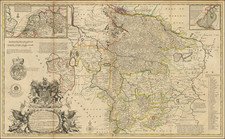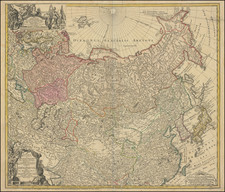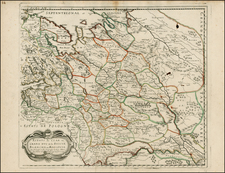The Official Soviet Map Used in the Battle of Berlin, April 1945.
Color-printed folding map of Berlin, issued by the Soviet Union in 1945. In many cases, these maps were carried into Berlin by front-line Red Army troops.
The map was issued in several editions in 1945. It declares itself to be derived from the original 1:15,000 mapping of Berlin. The editions can be differentiated by the text and number in the far lower left corner of the map. This edition is "Зак. 813 IV 45 Д". We do not know how many editions were published, nor what the differences between editions are; this is a subject worthy of further research.
We have handled the 1:25,000 Berlin map in other examples with contemporary manuscript annotations. This copy is clean.
"The Victory Map"
The Soviets also produced a four-sheet 1:15,000 map of Berlin in 1944-45. That original 4-sheet Berlin map was ordered on September 15, 1943, by Stavka (Headquarters of the Supreme Commander in the USSR). Prior to that order, there was no Russian up-to-date Berlin plan for military use, and there would have been no reason for optimism that such a map would ever be needed before 1943.
The mapping project was undertaken by Ленинградская военно-картографическая часть (Leningrad Military Mapping Unit) in the harsh conditions of the Siege of Leningrad. The cartographers used outdated 1930s German maps of Berlin, tourist guides, and even photographic postcards! They created over 6,000 Russian transcriptions for German streets, objects, and district names in Berlin. The map project was adjusted using aerial photography with the help of Dornier airplanes. Those planes were bought from Germany by USSR prior to the Second World War. As the war started, the planes were repainted and used by the Soviet army as spy planes over Germany and German-occupied territories. The original map was ready in January 1944. During the Spring of 1945, Поезд-литография ВТС (Lithography Train of the Military Topographic Service), a movable military printing shop, made a set of copies that were distributed directly to the key army officials. Some officers called the 1:15,000 map simply "The Victory Map". The 1:25,000 maps were probably printed on the same printing train and were used for tactical planning. The 1:15,000 map had additional features like a list of the most important civil and military organizations numbered and marked, technical data for the bridges, etc.
By early 1945, the Germans had all but lost the war on Eastern Front. The Red Army proved an unstoppable tidal wave, destroying the Wehrmacht division by division. Evacuation measures for Berlin had been prepared for the Reich government, ministries, and security apparatus starting in February of 1945. However, their implementation was delayed so that the commanders would not be seen to be admitting defeat. With two million Soviet soldiers quickly surrounding Berlin, Adolf Hitler finally gave the order to execute the defensive plan for the city on April 20th, 1945, his 56th birthday. The defenses barely slowed down the Red Army, and by early May they had totally subdued the city.

![[Battle of Berlin] План г. Берлин 1:25000 By Leningrad Military Mapping Unit](https://storage.googleapis.com/raremaps/img/small/68524.jpg)








![[First Postwar Elections in Germany] Elections au Bundestag 14 Aout 1949 Zone Francaise](https://storage.googleapis.com/raremaps/img/small/78830.jpg)


![[Signed Political Satire Artwork] Vietnam ... Vietnam ... Vietnam ...](https://storage.googleapis.com/raremaps/img/small/68726.jpg)
![[ Scandinavia ] Tabula Geographica Regnorum Sueciae Daniae et Norwegiae](https://storage.googleapis.com/raremaps/img/small/102797.jpg)
